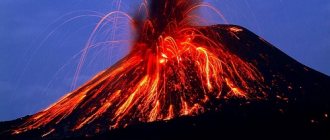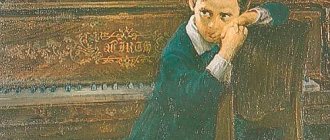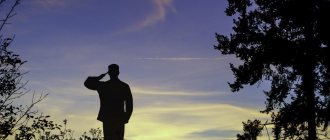What is a volcano and why is it called that?
Once upon a time in Ancient Greece there lived a god, and his name was Hephaestus. He was not famous for his beauty, he was lame, but he had a steely character, strength, and was very successful in blacksmithing. It was he who curbed fire and subsequently taught people how to make it.
Hephaestus lived and worked in his own forge, which he himself made inside the mountain. People said that if there is steam and fire above the mountain, then Hephaestus has begun his work. People were afraid. And they called Hephaestus the god of fire Vulcan, and his dwelling also began to be called Vulcan.
But this is just a beautiful legend. The word “volcano” itself comes from the Latin “vulkanus” and is translated as “fire”. In fact, a volcano is a rock formation on the surface of the earth with a huge hole on top, called a crater, from which magma periodically emerges, which becomes red-hot lava, spreading mixed with huge stones and surrounded by clouds of ash. Magma is liquid rock from underground. And lava is what magma turns into when it gets out and loses water and gas vapor.
How does a volcano work? Why does it erupt?
Usually, a volcano looks like a mountain in appearance; it is also in the shape of a cone or pyramid. Only here on top there is a huge hole down to the base, which is scientifically called a crater or vent. If suddenly somewhere the earth’s crust has a crack, then magma has every chance of getting there and pouring out through the mouth of the volcano. The emergence of a volcano is due to the fact that the earth moves and changes, and the composition of substances at depth also changes. The process is called an eruption.
Imagine a bottle of Coca-Cola that you shook and then decided to open the cap. There will be a pop, smoke will appear, and then foam. The thing is that so-called degassing occurs, and the liquid literally explodes. A volcano works on the same principle. But unlike foam, hot lava is very dangerous for humans. It can spread in different directions for many kilometers around. The action can last several hours or even several years. Lava destroys everything in its path, and gas clouds easily cause suffocation attacks in people and animals. It is almost impossible to hide from the eruption. The best way to escape is to evacuate in time.
Volcanoes can erupt in different ways. Some explode violently, then magma is thrown to a height, and then the red-hot lava spreads at an incredible speed in all directions. At the same time, the space around is shaken by a terrible roar, and a huge column of smoke rises around the volcano. And other volcanoes erupt quietly and calmly.
Volcanoes are active, dormant and extinct. Active volcanoes are the eruptions of which humanity remembers. The ones that fell asleep are those that did not erupt, but have every chance. Extinct - those that have not erupted for many thousands of years or have been destroyed. There are approximately 1,500 volcanoes on our planet, of which about 600 are active.
A volcanic eruption is a scary thing. However, it's not all bad. There is some benefit from this terrifying phenomenon that we cannot stop. For example, along with lava flows, minerals and hard rocks come to the surface, which are then used in construction, as well as metals necessary for industry. Pumice is also what the volcano gives us. And ash from a volcano is an excellent natural fertilizer for plants.
How does an eruption occur?
A typical volcano is a hill with a pipe running through it, called vent . This vent rises from a magma chamber . lava - rushes up the vent and is thrown into the air . This phenomenon is called a volcanic eruption . Sometimes, along with an eruption, rain falls, which, mixed with ash, turns into rivers of mud. Lava melts rocks and destroys all living things, and after the eruption it hardens into a hard crust. As these solid layers accumulate, the volcano grows. But a volcanic eruption is not always accompanied by a lava flow; sometimes it can be done without it.
Mount Kilimanjaro is the highest point in Africa. This snow-capped, extinct volcano stands out from the surrounding lowland savannahs.
The most famous volcanoes in the world
- Vesuvius. Located on the Apennine Peninsula in Italy. It was he who once wiped the city of Pompeii off the face of the earth.
- Fuji. Located on the island of Honshu in Japan. Translated from Japanese as “steepness, rock, hole.” An active volcano, but slightly active. Symbol of Japan. The most beautiful and romantic volcano in the world.
- Merapi. Located on the island of Java in Indonesia. Translated from the Javanese language as “fire mountain”.
- Koryak. Located on the Kamchatka Peninsula in Russia. It is named after the nearby village of Koryaki.
- Sakurajima. Located in Japan. Translated from Japanese as “Sakura Island”. This is an active volcano, recognized as one of the most dangerous.
- Etna. Located on the Italian island of Sicily. From the ancient Greek “aitos” is translated as “fire”. Locals believe that the volcano cures diseases. Sometimes festivals are held here.
- Kilimanjaro. It is the oldest and most famous volcano in Africa.
Experience. DIY volcano at home
Cut out a large enough circle from paper and cut it in half. Now roll one part into a cone, secure it with paper clips and set it aside. Now we need a paper cylinder made of durable material, for example, a tube of paper towels or foil. We glue this cylinder onto some surface, cardboard, a candy box, etc. This will be our mouth, onto which we put a paper cone. We cover the structure with paper tape and generously lubricate it with glue. To make the volcano look like a volcano, sprinkle it with multi-colored sand or grains and paint it. Now the most interesting part: to make the volcano erupt: mix a teaspoon of soda with red dry paint, add 5 drops of dishwashing liquid. Pour this into the mouth and add another 5 drops of vinegar there. Ready! Our volcano has awakened and is erupting!
In the video below, my son and I are making our own volcano from an experiment kit. At the end, we add our own variation of the eruption using paints, soda and vinegar. My son’s main phrase: “You can watch this forever!”...
Largest eruptions
The eruption of Mount Tambora , located on the Indonesian island of Sumbawa, which occurred in 1815, is considered the most powerful in human history. The explosion of the volcano was heard on the island of Sumatra, that is, 2 thousand km from Tambora! More than 70 thousand people died because of this disaster.
The newly rebuilt city of Saint-Pierre next to the active volcano Mont Pelée in Martinique
Mont Pelee volcano , located in the northern part of the island of Martinique, suddenly woke up on the morning of May 8, 1902 and covered the nearby city of Saint-Pierre with a hot cloud of pellet and gas. As a result of the eruption, about 30 thousand people died.
Volcano Nevado del Ruiz , located in Colombia, has repeatedly presented residents of nearby settlements with unpleasant surprises in the form of eruptions. However, on November 13, 1985, the volcano raged in earnest. It produced a powerful emission of burning rocks, which melted glaciers and caused mud flows. They, in turn, destroyed the city of Armero, which stood 46 km from the source of the eruption. As a result of the disaster, about 25 thousand people died.
Ruins of the city of Pompeii. Almost all the inhabitants of the cities of Pompeii and Herculaneum died as a result of the terrible eruption of Mount Vesuvius, which occurred on August 24, 79 AD. e.
Riddles about volcanoes
Volcano riddles for children are a simple and fun way to reinforce information about volcanoes. They will help you remember the features and signs of this unique natural phenomenon.
Where fire flies from the mountain, And smokes from all sides, There is a dangerous hooligan, Awakened again... (Volcano)
I spit fire and lava, I am a dangerous giant, I am famous for my evil reputation. What is my name... (Vulcan)
Grandfather Trofim smokes, smokes, and blows smoke into the sky. But as soon as he coughed, fire rushed into the sky... (Volcano)
That rather large mountain has a quiet character for the time being. But this can happen - It will explode, smoke... (Volcano)
The mountain woke up from sleep, began to seethe and boil. And a lot of smoke, soot, and ash rose up from the cap. The lava flows like honey, thick. How to name a mountain like this... (Volcano)
I am a black scary giant. I decide for myself what to do. I can sleep, I can growl, I can spew fire and ashes. Well, try to guess what my name is... (Volcano)
When he sleeps, everything is calm, but if he wakes up, there will immediately be thunder and an earthquake. It also brings destruction. (Volcano)
There is a natural phenomenon called an “eruption”. Lava flows from the mountain, Ash blows and blows in the sky. Tell me now, Who is the culprit of these affairs? (Volcano)
The mountain is smoking, smoking, Ashes are blowing into the ocean, You can hear the mountain snoring, Don’t wake up! Sleeping...(Volcano)
There is a hole at the top. It's hot inside! Sometimes it releases lava. Find justice for her... (Volcano)
A hurricane of a hot and evil disposition soared into the sky: Having uncorked a jug from a stone, molten lava poured down and swirled poison in the air, an angry gray-haired... (Volcano)
Yellowstone Caldera
The structure of the Yellowstone caldera
The Yellowstone Caldera is one of the largest known volcanoes in the world, and it is not just one volcano, but an entire system. It is located in North America. Calderas are large, crater-like basins formed after the collapse of the top of a long-dormant or extinct volcano. The size of the giant Yellowstone caldera is about 55x72 km. The first powerful eruption of the supervolcano occurred 2.1 million years ago, then 1.3 million and 640,000 years ago. Now there are from 1 to 20 earthquakes a day, but they are very weak - with a magnitude of no more than 3 points.
Poems about volcanoes
Poems about volcanoes are another way to learn information about volcanoes in rhythm and rhyme.
* * *
Volcanoes began to “volcano” - spew lava from their craters. Lava flowed down the slopes and severely burned the Earth. Centuries later, the evil Vulcan coughed up both ash and ash. The volcano is thundering! The volcano is chugging! How menacing he looks now! But then he began to get tired - The fire in him began to fade. He breathed fire for the last time - And fell asleep for decades. Centuries will pass... And again the volcano will wake up, And lava will flow from its interior.
* * *
Here the volcano is a mountain, and inside the mountain there is a hole. Smoke is coming from the mountain, stones are flying, gray smog. There was a rumble here and there: a volcano was awakening. The whole mountain trembled, Magma ran like lava, Stones and ashes flew, The sky was barely visible. Don’t go, my dear, where the awakened volcano is.
Andreeva-Doglyadnaya M.
* * *
The volcano stands in the middle of the desert, is silent, does not breathe, does not creak, but only underground, in the depths, He melts the earth, stirs up.
Already in the depths of the magma is boiling, fire is moving through the crater, and everything is burning, the old, ancient stench of anger does not disappear.
The magma boiled for a long time, rushing upward, to smash, to destroy; The time has come for rage to destroy and demolish everything.
You can see the stone crumbling - A terrible panel from hell - The sky has become dark blue: It will be gloomy forever.
Finally, a flame erupted, a river flows through the volcano, Lava gives the mountain an ornament, and it all becomes red.
The stream has cooled for miles. The apogee has long been asleep and stands, neither alive nor dead, but this volcano is extinct...
Beregovsky D.
* * *
Vesuvius opened its mouth - smoke poured out in a cloud - the flames developed widely, like a battle flag. The earth is agitated - idols are falling from the shaky columns! The people, driven by fear, Under the rain of stones, under the inflamed ashes, In crowds, old and young, flee from the city.
Alexander Pushkin
Volcanic activity
Volcanoes are divided depending on the degree of volcanic activity into active, dormant, extinct and dormant. An active volcano is considered to be a volcano that erupted during a historical period of time or in the Holocene. The concept of active is quite inaccurate, since a volcano with active fumaroles is classified by some scientists as active, and by others as extinct. Dormant volcanoes are considered to be inactive volcanoes where eruptions are possible, and extinct volcanoes are considered to be those where they are unlikely.
However, there is no consensus among volcanologists on how to define an active volcano. The period of volcanic activity can last from several months to several million years. Many volcanoes exhibited volcanic activity tens of thousands of years ago, but are not considered active today.
Astrophysicists, from a historical perspective, believe that volcanic activity, caused, in turn, by the tidal influence of other celestial bodies, can contribute to the emergence of life. In particular, it was volcanoes that contributed to the formation of the earth's atmosphere and hydrosphere, releasing significant amounts of carbon dioxide and water vapor. Scientists also note that too active volcanism, such as on Jupiter's moon Io, can make the planet's surface uninhabitable. At the same time, weak tectonic activity leads to the disappearance of carbon dioxide and sterilization of the planet. “These two cases represent potential boundaries for planetary habitability and exist alongside the traditional parameters of habitable zones for systems of low-mass main sequence stars,” the scientists write.
Types of volcanic structures
In general, volcanoes are divided into linear and central, but this division is arbitrary, since most volcanoes are confined to linear tectonic faults (faults) in the earth’s crust.
Linear volcanoes or fissure-type volcanoes have extensive supply channels associated with a deep split in the crust. As a rule, basaltic liquid magma flows out of such cracks, which, spreading to the sides, forms large lava covers. Along the cracks, gentle spatter shafts, wide flat cones, and lava fields appear. If the magma has a more acidic composition (higher silicon dioxide content in the melt), linear extrusive ridges and massifs are formed. When explosive eruptions occur, explosive ditches can appear tens of kilometers long.
The shapes of central-type volcanoes depend on the composition and viscosity of the magma. Hot and easily mobile basaltic magmas create vast and flat shield volcanoes (Mauna Loa, Hawaiian Islands). If a volcano periodically erupts either lava or pyroclastic material, a cone-shaped layered structure, a stratovolcano, appears. The slopes of such a volcano are usually covered with deep radial ravines - barrancos. Volcanoes of the central type can be purely lava, or formed only by volcanic products - volcanic scoria, tuffs, etc. formations, or be mixed - stratovolcanoes.
There are monogenic and polygenic volcanoes. The former arose as a result of a single eruption, the latter as a result of multiple eruptions. Viscous, acidic in composition, low-temperature magma, squeezed out of the vent, forms extrusive domes (Montagne-Pelé needle, 1902).
In addition to calderas, there are also large negative forms of relief associated with subsidence under the influence of the weight of erupted volcanic material and a pressure deficit at depth that arose during the unloading of the magma chamber. Such structures are called volcanotectonic depressions. Volcanotectonic depressions are very widespread and often accompany the formation of thick strata of ignimbrites—silicic volcanic rocks of various origins. They are lava or formed by sintered or welded tuffs. They are characterized by lens-shaped segregations of volcanic glass, pumice, lava, called fiamme, and a tuff or tofo-like structure of the main mass. As a rule, large volumes of ignimbrites are associated with shallow magma chambers formed due to the melting and replacement of host rocks. Negative relief forms associated with central-type volcanoes are represented by calderas - large round-shaped sinkholes several kilometers in diameter.







